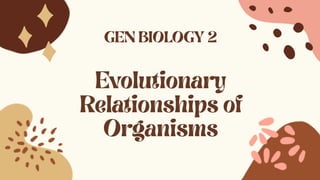
Molecular Comparisons Reveal Evolutionary Relationships
- 2. Topic Outline A recognize how comparisons of similarities and differences can suggest evolutionary relationships B explain the significance of using multiple lines of evidence to identify evolutionary relationships C infer the degree of relationships among organisms based on the amino acid sequence in the cytochrome c molecule
- 3. • All life on Earth arose from a single common ancestor, and our genes reflect this shared ancestry. As species differentiated over evolutionary time, the DNA sequences in their genes acquired slight changes. According to evolutionary theory, these changes accumulate over time: species that diverged from each other long ago have more differences in their DNA than species that diverged recently.
- 4. • Living things share some biomolecules which may be used to prove relationships. These chemicals include DNA and proteins. The building blocks of these chemicals may be analyzed to show similarities and differences among organisms. The more similarities, the closer the relationships.
- 5. Molecular Comparisons • With the advancement of DNA technology, the area of molecular systematics, which describes the use of information on the molecular level including DNA sequencing, has blossomed. New analysis of molecular characters not only confirms many earlier classifications, but also uncovers previously made errors. Molecular characters can include differences in the amino-acid sequence of a protein, differences in the individual nucleotide sequence of a gene, or differences in the arrangements of genes.
- 6. • One example that supports the molecular evolutionary relationships is the basis from the protein cytochrome-c, an important enzyme found in virtually all organisms. It is a highly conserved protein which functions in the electron transport chain system of the mitochondria which is needed for the release of energy from food. The Molecular mitochondria which is needed for the release of energy from food. It also performs a role in apoptosis (programmed cell death) by being released into the cytosol activating the events of cell death. The diagram below shows the structure of cytochrome c and its location in the mitochondrial inner membrane
- 10. • Two Options for Similarities • In general, organisms that share similar physical features and genomes tend to be more closely related than those that do not. Such features that overlap both morphologically (in form) and genetically are referred to as homologous structures; they stem from developmental similarities that are based on evolution. For example, the bones in the wings of bats and birds have homologous structures. • Notice it is not simply a single bone, but rather a grouping of several bones arranged in a similar way. The more complex the feature, the more likely any kind of overlap is due to a common evolutionary past.
- 11. • Some organisms may be very closely related, even though a minor genetic change caused a major morphological difference to make them look quite different. Similarly, unrelated organisms may be distantly related, but appear very much alike. This usually happens because both organisms share common adaptations that evolved within similar environmental conditions. For example, insects use wings to fly like bats and birds, but the wing structure and embryonic origin is completely different. These are called analogous structures
- 12. HOMOLOGOUS STRUCTURES • similar physical features in organisms that share a common ancestor, but the features serve completely different functions. ANALOGOUS STRUCTURES • features of different species that are similar in function but not necessarily in structure and which do not derive from a common ancestral feature
- 13. EVOLUTION IN ACTION: What is Phylogeny and Why Does It Matter? • Phylogeny is the study of relationships among different groups of organisms and their evolutionary development. Phylogeny attempts to trace the evolutionary history of all life on the planet. It is based on the phylogenetic hypothesis that all living organisms share a common ancestry.
- 14. Building Phylogenetic Trees • How do scientists construct phylogenetic trees? Presently, the most accepted method for constructing phylogenetic trees is a method called cladistics. This method sorts organisms into clades, groups of organisms that are most closely related to each other and the ancestor from which they descended.
- 15. • Clades can vary in size depending on which branch point is being referenced. The important factor is that all of the organisms in the clade or monophyletic group stem from a single point on the tree. This can be remembered because monophyletic breaks down into “mono,” meaning one, and “phyletic,” meaning evolutionary relationship. The figure below shows various examples of clades. Notice how each clade comes from a single point, whereas the non-clade groups show branches that do not share a single point.
- 16. To make the Cladogram, we must observe which characteristics are more or less commonly held
- 17. Through this cladogram, we can conclude that among the organisms crocodiles and birds are the most closely related, while butterflies are the outgroup
- 18. cells legs 6 legs wings worms spider carpenter ant (black) fly
- 19. cells present present present present legs absent present present present 6 legs absent absent present present wings absent absent absent present worms spider carpenter ant (black) fly
- 20. • To build phylogenetic trees, scientists must collect character information that allows them to make evolutionary connections between organisms. Using morphologic and molecular data, scientists work to identify homologous characteristics and genes. Similarities between organisms can stem either from shared evolutionary history (homologies) or from separate evolutionary paths (analogies). After homologous information is identified, scientists use cladistics to organize these events as a means to determine an evolutionary timeline. Scientists apply the concept of maximum parsimony, which states that the likeliest order of events is probably the simplest shortest path. For evolutionary events, this would be the path with the least number of major divergences that correlate with the evidence. Section Summary
- 21. Thank you for listening! Don't hesitate to ask any questions!